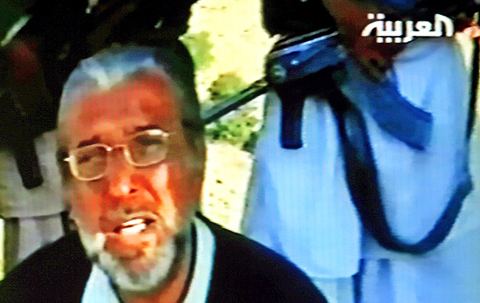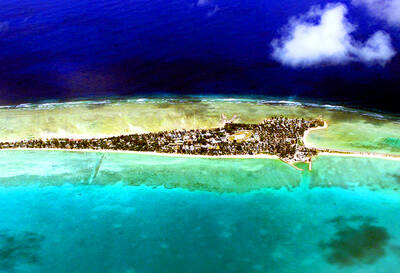Suspected Taliban militants have released Pakistan's envoy to Afghanistan more than three months after he was kidnapped in Pakistan's Khyber tribal region, a senior government official said yesterday.
“I can confirm he is released, and he is safe and sound,” Foreign Ministry spokesman Mohammed Sadiq said.
Tariq Azizuddin, 56, went missing on Feb. 11 along with his driver and a guard as he was traveling from the northwestern city of Peshawar to the Afghan-Pakistani border. He was on his way back to the Afghan capital, where he had been ambassador since 2005.

PHOTO: AFP
The route winds through the historic Khyber Pass, the main link between landlocked Afghanistan and northwestern Pakistan, and a major supply route for foreign forces in Afghanistan.
Pakistani television channels said the envoy had been freed in Afghanistan.
A relative said Azizuddin was expected to return home to his family in Pakistan shortly.
“The authorities contacted us and said that Aziz has been released and he would be back by the evening,” a family member said.
Last month, Azizuddin appeared in a video on an Arabic television station saying he was being held by the Taliban.
The bespectacled and gray-bearded ambassador complained of high blood pressure and chest pains in the video, which showed two of his captors wearing baggy trousers and tunic and brandishing assault rifles.
He said in the video that he had been taken with his driver and bodyguard, who were also shown sitting beside him.
Azizuddin had pleaded in the video for the government and the foreign ministry “to do all they can to protect our lives and to answer all the demands of the mujahidin of Taliban in order to secure our release.”
The day of his kidnap coincided with Pakistani security forces seizing a senior Taliban commander, Mullah Mansoor Dadullah, in southwestern Baluchistan province, also bordering Afghanistan.
Azizuddin did not say what demands the Taliban were making, but Pakistani media reports had reported they had called for the release of several jailed militants.
A Pakistani Taliban spokesman had earlier denied that members the guerrilla movement were responsible for abducting the envoy.
Pakistan’s new government, sworn in at the end of March, has begun a policy of engagement, negotiating through tribal leaders to bring peace to a region where Pakistani security forces have been struggling to contain a growing Taliban insurgency. The long tribal belt on the border is notorious for being a haven for smugglers and bandits and turned into a major sanctuary for al-Qaeda and the Taliban militants who fled from Afghanistan after a US-led invasion in the wake of the attacks on Sept. 11, 2001.
The ambassador’s recovery comes amid recent headway in talks between the Pakistani Taliban and the six-month-old coalition government led by Pakistani Prime Minister Yousuf Raza Gilani.
Pakistan’s new government defeated backers of Pakistani President Pervez Musharraf in elections in February and has pledged to completely overhaul the key US ally’s pursuit of the “war on terror.”
As part of the ongoing peace process, the authorities last month released some 30 tribesmen held in various prisons in return for the release of 55 soldiers detained by pro-Taliban militants, an official said.
It was not immediately known whether a swap led to the release of the envoy.

DISASTER: The Bangladesh Meteorological Department recorded a magnitude 5.7 and tremors reached as far as Kolkata, India, more than 300km away from the epicenter A powerful earthquake struck Bangladesh yesterday outside the crowded capital, Dhaka, killing at least five people and injuring about a hundred, the government said. The magnitude 5.5 quake struck at 10:38am near Narsingdi, Bangladesh, about 33km from Dhaka, the US Geological Survey (USGS) said. The earthquake sparked fear and chaos with many in the Muslim-majority nation of 170 million people at home on their day off. AFP reporters in Dhaka said they saw people weeping in the streets while others appeared shocked. Bangladesh Interim Leader Muhammad Yunus expressed his “deep shock and sorrow over the news of casualties in various districts.” At least five people,

ON THE LAM: The Brazilian Supreme Court said that the former president tried to burn his ankle monitor off as part of an attempt to orchestrate his escape from Brazil Former Brazilian president Jair Bolsonaro — under house arrest while he appeals a conviction for a foiled coup attempt — was taken into custody on Saturday after the Brazilian Supreme Court deemed him a high flight risk. The court said the far-right firebrand — who was sentenced to 27 years in prison over a scheme to stop Brazilian President Luiz Inacio Lula da Silva from taking office after the 2022 elections — had attempted to disable his ankle monitor to flee. Supreme Court judge Alexandre de Moraes said Bolsonaro’s detention was a preventive measure as final appeals play out. In a video made

It is one of the world’s most famous unsolved codes whose answer could sell for a fortune — but two US friends say they have already found the secret hidden by Kryptos. The S-shaped copper sculpture has baffled cryptography enthusiasts since its 1990 installation on the grounds of the CIA headquarters in Virginia, with three of its four messages deciphered so far. Yet K4, the final passage, has kept codebreakers scratching their heads. Sculptor Jim Sanborn, 80, has been so overwhelmed by guesses that he started charging US$50 for each response. Sanborn in August announced he would auction the 97-character solution to K4

SHOW OF FORCE: The US has held nine multilateral drills near Guam in the past four months, which Australia said was important to deter coercion in the region Five Chinese research vessels, including ships used for space and missile tracking and underwater mapping, were active in the northwest Pacific last month, as the US stepped up military exercises, data compiled by a Guam-based group shows. Rapid militarization in the northern Pacific gets insufficient attention, the Pacific Center for Island Security said, adding that it makes island populations a potential target in any great-power conflict. “If you look at the number of US and bilateral and multilateral exercises, there is a lot of activity,” Leland Bettis, the director of the group that seeks to flag regional security risks, said in an